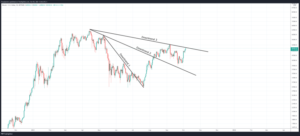August 30, 2021
 By Wayne Duggan
By Wayne Duggan
Short sellers have gotten a lot of negative attention in 2021. But while some short sellers engage in nefarious practices, betting against overvalued, overheated or downward-trending stocks has always been a very useful trading strategy.
Buying put options and short selling are two of the most popular ways to bet on a stock price falling instead of rising. Here are the pros and cons of each strategy.
What to Know About Short-Selling
Short-selling is the practice of borrowing shares of stock from your broker and then selling them in the hopes of buying them back again (covering) at a lower price in the future. In doing so, you are theoretically pocketing the difference between the proceeds you gained when you opened the position and the price you paid to buy back the shares to cover.
However, there are also clear cons to short selling. One con is that you are typically paying a borrow fee on the shares you short. For most stocks, that borrowing fee is minimal, but for heavily shorted stocks it can be pricey.
Short-selling also has an upside cap on gains at 100%. A stock price can’t drop below zero, so the best you can do on a short bet is doubling your money. At the same time, the loss potential is theoretically unlimited. If the stock you shorted triples, you’ve lost double the size of your initial position.
Finally, short sellers may be subject to forced buy-ins or margin calls if a stock they shorted rises significantly. In these scenarios, brokers may force a short seller to close out their position at the worst possible time, resulting in large losses.
What to Know About Put Buying
One popular alternative to short selling is buying put options. Put options give the buyer the right to sell shares of stock at the contract’s strike price on the contract’s expiration date.
There are several pros to buying put contracts. First, put contracts have downside capped at 100% of the premium paid while the max potential upside is the strike price minus the premium paid. In the event a short squeeze or buyout sends the stock skyrocketing, you won’t end up potentially losing 200%, 300% or even 1,000% of your initial position.
One con of buying put options is that even if you are correct in predicting a negative price movement, you may still lose money on put options if the stock doesn’t move far enough in the right direction. When you buy an option contract, you are paying a time value premium up front that you only recover if the stock moves far enough below the strike price. When shorting a stock, every cent the stock moves in your direction is a profit.
Another disadvantage of buying puts is time. You can theoretically wait as long as you want for your short position to pay off, but a put buy must work by the expiration date of the contract.
And the Winner Is…
Unfortunately, there is no clear winner between put-buying and short-selling. Both strategies have pros and cons that make them each useful in unique ways given a trader’s strategy, risk tolerance and goals.
Active Trading with Lightspeed
Lightspeed provides professional traders with all the tools required to help them find success in stock trading, and we have been developing and honing our active trader platform to offer an optimal user experience. With the intuitive interface layouts and institutional quality stock and options scanners, we aim to help traders reach their goals, no matter what their strategy is. We also offer our clients some of the lowest trading fees in the industry.
For more information on a professional trading platform with Lightspeed, please call us at 1-888-577-3123, request a demo, or to open an account.
Lightspeed Financial Services Group LLC is not affiliated with these
third-party market commentators/educators or service providers. Data,
information, and material (“content”) are provided for informational and
educational purposes only. This content neither is, nor should be construed as
an offer, solicitation, or recommendation to buy or sell any securities or
contracts. Any investment decisions made by the user through the use of such
content is solely based on the users independent analysis taking into
consideration your financial circumstances, investment objectives, and risk
tolerance. Lightspeed Financial Services Group LLC does not endorse, offer nor
recommend any of the services or commentary provided by any of the market
commentators/educators or service providers and any information used to execute
any trading strategies are solely based on the independent analysis of the user.
You may also be interested in…
- 2021
- All
- analysis
- bearish
- BEST
- Betting
- Borrowing
- broker
- brokers
- buy
- Buying
- call
- clients
- Commentary
- content
- contract
- contracts
- data
- Drop
- educational
- Event
- experience
- financial
- financial services
- First
- future
- Goals
- Group
- here
- HTTPS
- industry
- information
- Institutional
- investment
- IT
- large
- lightspeed
- LLC
- Long
- Market
- money
- Most Popular
- move
- moves
- offer
- Option
- Options
- Pay
- Popular
- Premium
- price
- Profit
- quality
- Recover
- Risk
- Securities
- sell
- Sellers
- Services
- Shares
- Short
- Shorting
- Size
- So
- stock
- stock trading
- Stocks
- Strategy
- success
- The Future
- time
- tolerance
- trader
- Traders
- Trading
- Trading Strategies
- triples
- us
- users
- value
- wait
- Work
- zero




